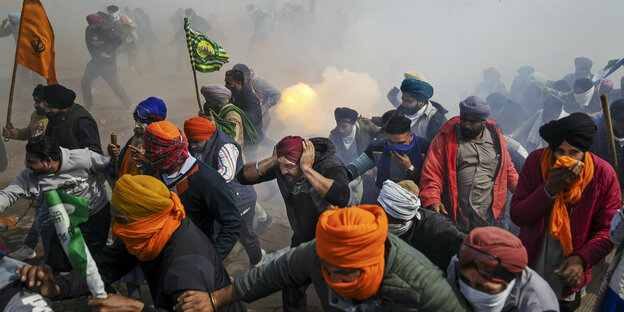Is it possible to maintain confidence in democratic processes through tear gas and rubber bullets? At least not in India.

Tear gas against protesting farmers in Punjab, northern India, on February 21. Photo: Altaf Qadri/ap
Currently, northern India is covered not only in winter smog, but also in smoke from tear gas used by government troops against people working to put food on the table.
Indian farmers protested in 2020 and 2021 against laws that would severely affect agriculture in India. Up to 700 of them died during the protests. The laws would have left small farmers at the mercy of big companies. Similar to the US and, more recently, the EU agricultural model, which is hitting farmers hard and keeping fresh produce prices in supermarkets surprisingly low.
This led to widespread protests that demonstrated to the government that a religious fascist ideology was not enough to win the support of farmers who once supported the government. The laws were then repealed, demonstrating to India and the world the power of unions and mass movements. But the farmers knew that was not the end of their fight.
Let's go back to the current scenario, when the ministers met the leaders of the farmers' unions. They agreed to most of the demands, including the withdrawal of criminal cases launched against the protesting farmers at the time. However, the question of the minimum price remained. It would guarantee farmers a purchase in state-controlled wholesale markets.
First I laughed and then I got angry at this white man's idea of what my country should be.
Unable to solve this problem, farmers, organized in more than 200 unions, took to the streets again in February. Imagine the number of people flocking to the capital, New Delhi, to protest. Imagine the fear of the State surrounding the city with barricades.
One photo says it all: farmers from the northern state of Punjab in their turbans and clinging to their plows, while on the other side of the barricades there is a huge queue of police and armed forces in riot gear, most of them children of the farmers who Now they are one of those who should fight for their own. An expert rightly said who is the real opposition to the anti-worker fascist government: the millions of farmers in India.
I remember sitting at a conference in Hamburg in 2015 when a German, a so-called expert on India's economy, said the only way to improve it was to end dependence on agriculture. First I laughed and then I got angry at this white man's idea of what my country should be. It is possible that his ancestors were also people who worked with their own hands, but he has forgotten his own history.
None of the farmers who take to the streets in India, risking injury from tear gas or rubber bullets, do so because they have free time after harvesting. They show us what it means to do work with dignity, beyond the sophisticated world of selling economics on the computer screen. They show us what democratic processes – and their enforcement – really mean.